Abstract
Background: The detection of mutations from circulating tumor DNA (ctDNA) represents a promising enrichment technique. In this retrospective study, the significance of ctDNA and imaging in Langerhans cell histiocytosis (LCH) monitoring was first examined, and the broader role of ctDNA in monitoring LCH was additionally explored. Methods: First, data visualization and survival analysis models were used to generalize the concordance between cfBRAFV600E molecular response and radiographic response on clinical outcomes. Next, the molecular response of cfBRAFV600E was observed from a dynamic perspective. A comparative analysis was then conducted between cfBRAFV600E and ltBRAFV600E status, examining their relationship to clinical manifestations and prognosis of LCH. Results: Eventually, 119 participants were enrolled in this trial between 2019 and 2023. Progression-free survival (PFS) was significantly shorter in patients with both radiologic and cfDNA molecular progression (17.67 versus 24.67 months, p < 0.05) compared to those without. A critical cfBRAFV600E value of 0.03% has been determined for the first time. Both cfBRAFV600E and ltBRAFV600E mutations were associated with a higher proportion of children under 3 years of age, skin and spleen involvement, and a lower 3-year PFS rate. In contrast to ltBRAFV600E, cfBRAFV600E was linked to a higher proportion of risk organ invasion LCH (52% vs. 27.9%, p < 0.05) and a better therapeutic response at the sixth week (24% vs. 4.7%, p < 0.05). Furthermore, in patients with risk organ invasion-LCH and multisystem-LCH subtypes, cfBRAFV600E was associated with a significantly lower 3-year PFS. Conclusions: In summary, these findings enhanced and supplemented the implications of ctDNA and imaging analysis application in children with LCH.
1. Introduction
Langerhans cell histiocytosis (LCH) is the most prevalent form of childhood histiocytosis, characterized by CD207-positive histiocytes that form granulomatous lesions accompanied by localized infiltration of inflammatory cells [1,2,3]. LCH is currently considered to be an inflammatory neoplastic disease of myeloid origin. The incidence rate of LCH in children aged 0–15 years ranges from 2 to 3 per 500,000 annually [4,5]. LCH can affect nearly every organ in the body, with the number and location of affected organs varying significantly. The bones, skin, and pituitary gland are the most commonly impacted [6,7]. The clinical presentation of LCH is heterogeneous, and there are many pitfalls or difficulties in pathological diagnosis, often leading to misdiagnosis or missed diagnosis [8,9,10]. The involvement of the liver, spleen, or bone marrow is associated with the highest risk of death in children, so the liver, spleen, or bone marrow are classified as high-risk organs [6,11]. A recent study has found that severe hematological involvement (SHI, defined as hemoglobin ≤7 g/dL and platelets ≤20 G/L) in LCH is associated with distinct clinical features, higher complication rates, and poorer outcomes [12]. The progression of LCH is primarily driven by aberrant activation of the MAPK signaling pathway, with the BRAFV600E mutation being particularly significant, detected in approximately 38% to 68% of pediatric patients [7,13,14]. The study revealed that MAPK/PI3K pathway alterations were present in 77.6% of adult LCH patients [15].
There are three rapidly accelerating fibrosarcoma (RAF) in mammalian cell genes, namely ARAF, BRAF, and CRAF [3,16]. BRAF can be activated by the oncogene RAS and drives cell proliferation via the RAS-RAF-MEK-ERK pathway, which is activated in all LCH patients. The BRAFV600E mutations result in sustained activation of BRAF, leading to tumorigenesis by promoting cellular differentiation, resistance to apoptosis, and oncogene-induced senescence [7,17]. Tumorigenesis may also arise from other activating mutations in BRAF, such as the BRAFV600DLAT mutation and the BRAFV600D mutation. MAP2K1, encoding the MEK1 protein, is the second most commonly mutated target after BRAF. The mutual exclusivity of BRAF and MAP2K1 mutations in LCH requires further validation [18,19].
Liquid biopsy uses a minimally invasive approach to obtain samples, such as blood or bone marrow, for testing. Circulating tumor DNA (cfBRAFV600E may become a key indicator for changing) is referred to as a “liquid biopsy” because it detects cancer-related DNA fragments in the bloodstream, offering a minimally invasive alternative to traditional tissue biopsies. This technique holds bright promise for early detection, diagnosis, prognostic analyses, and real-time monitoring of response to treatment and recurrence of cancerous cancers [20,21]. In recent years, numerous studies have highlighted the potential of liquid biopsies for tracking molecular events, evaluating minimal residual disease, and assessing prognosis in LCH [22,23,24]. Circulating free DNA (cfDNA) refers to DNA fragments freely circulating in the bloodstream and originating from any cell type, not exclusively from tumors. As a minimally invasive test, cfDNA promises to be used as an alternative adjunct to currently available modalities. To investigate the correlation between cfBRAFV600E molecular response, radiographic response, and LCH progression, we analyzed 119 plasma and tissue samples. To investigate the correlation between cfBRAFV600E molecular response, radiographic response, and LCH progression, we analyzed 119 plasma and tissue samples. Our paper aims to explore the concordance between circulating tumor DNA (ctDNA) testing and imaging analysis in the monitoring of Langerhans cell histiocytosis (LCH) to more accurately determine treatment outcomes and the disease state in children. In this work, we focus on how these two modalities can complement each other to enhance diagnostic accuracy and patient management, and the final goal is to examine the broader role of ctDNA in monitoring the disease.
2. Methods
2.1. Study Design
The enrollment criteria included pathologically confirmed LCH and no prior exposure to chemotherapy before the first-line protocol. All children received the Chinese Children’s Histiocytic Group (CCHG)-LCH-2019 treatment regimen, consisting of mainline chemotherapy with vincristine (1.5 mg/m2) and prednisone (40 mg/m2). This regimen involved 6 weeks of induction therapy across two courses, followed by maintenance therapy with or without 6-Mercaptopurine (50 mg/m2) monohydrate for a total duration of one year. At the time of initial diagnosis, ten unstained pathology slides were selected for mutation detection via lesion tissue DNA (ltDNA), and 10 mL of peripheral blood was drawn for cfDNA testing prior to chemotherapy. ltDNA is typically performed post-diagnosis using Next-Generation Sequencing (NGS) or real-time Quantitative Polymerase Chain Reaction (qPCR). cfDNA was collected and reviewed every 6 weeks during the later stage with specific qPCR and droplet digital PCR (ddPCR) (Figure 1A).
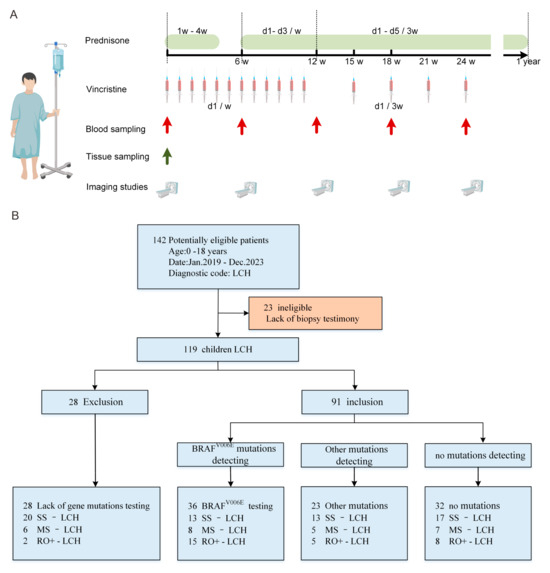
Figure 1.
(A) The Chinese Children’s Histiocytic Group (CCHG)-Langerhans Cell Histiocytosis (LCH)-2019 treatment regimen. (B) Flow diagram of patients: 119 newly diagnosed pediatric LCH cases (1–18 years of age) were studied between 2019 and 2023. SS-LCH: single system-LCH; MS-LCH: multisystem LCH; RO+-LCH: risk organ invasion LCH.
Imaging studies include ultrasound (US), CT, MRI, and positron emission tomography-CT (PET-CT) of involved and suspected lesions. The involvement of LCH on imaging findings was categorized based on anatomical location and descriptions from previous studies [4,10]. Lesion tissue that was not measurable by imaging, such as skin lesions, was excluded from the assessment of detectability. A quantitative analysis of lesions based on the US, CT, MRI, and PET-CT data was retrospectively obtained in consensus from 2 radiologists with more than 10 years of experience. A third radiologist with more than 20 years of experience resolved all divergences between the two reviewers. Except for the diagnosis of LCH, the patient’s clinical data and other imaging results were blinded to the radiologists during the first to the last follow-up. The main content of the imaging analysis included the following: (1) density/signal intensity, size, border, morphology, enhancement pattern, and degree of enhancement of the lesion; (2) extent of the lesion, including its location, involvement of peripheral blood vessels, and lymph nodes; (3) evolution of the lesion site, with comparative analyses during the follow-up period; (4) identification of suspicious lesions, determining whether they are tumors or nonspecific abnormalities; (5) measurement of the pituitary gland height; (6) length and thickness of the liver and spleen and assessment of fibrosis, characterized by patchy, nodular, or fused non-enhanced abnormalities diffusely distributed in the liver on non-enhanced images.
The methods used to assess the disease status at the 6th week included routine blood counts, biochemical tests, height measurements, urine osmolality, and endocrine tests (if necessary), along with imaging of affected and suspected areas. Basic clinical information was collected, including age, sex, disease extent at diagnosis, involvement lesions, 3-year progression-free survival (PFS) rate, and the response to chemotherapy at the 6th week.
2.2. Study Enrollment and Participants
This study retrospectively screened 142 pediatric LCH cases (1–18 years of age) admitted to X Hospital from 2019 to 2023. Of these, 119 newly diagnosed pediatric LCH cases were consecutively enrolled. Tumor tissue DNA (ltDNA) and cfDNA were prepared from 91 patients. Lab data from 23 patients were excluded for lacking LCH biopsy testimony (Figure 1B). The diagnostic criteria, the clinical classification, and the classification of organs at risk for LCH are detailed in Supplementary Table S1. The study was approved by the Ethics Committee, and informed consent was obtained from the parent or legal guardian of each individual participant included in the study. All patients were assessed for disease status in the 6th, 12th, 26th, and 52nd weeks to inform the subsequent course of the treatment plan. Disease status was classified as follows: (1) no active disease (NAD): complete resolution of symptoms with normal imaging findings; (2) active disease (AD): (i) active disease-better (AD-B): some of the lesions improved, without any worsening of existing lesions; (ii) active disease-intermediate (AD-I): some lesions improved while others worsened, or new lesions appeared; (iii) active disease-stable (AD-S): original symptoms and signs remain without the emergence of new lesions; (iv) active disease-worse (AD-W): worsening of existing symptoms or the appearance of new lesions. Patients presenting with a solitary skin involvement or a single non-central nervous system (CNS) bone involvement will not initially undergo chemotherapy. Instead, they will be evaluated every 3 months and will commence the first-line treatment regimen only if the evaluation outcome indicates AD-I or AD-W. PFS rate was defined as the percentage of patients who did not experience LCH progression, disease relapse, or death. LCH relapse is defined as the infiltration of new lesions after the original LCH lesion has been cured. LCH progression was defined as (a) aggravation or lack of improvement in the affected lesion, (b) partial improvement or worsening of lesions, or the emergence of new lesions, and (c) initiation of a second/further-line chemotherapy [25,26]. We defined the increase in the proportion of BRAFV600E mutations during follow-up as cfDNA molecular progression, and we defined radiologic progression as that patient had radiographic disease progression. cfDNA molecular response, radiologic response, and clinical outcomes were assigned in a blinded manner.
2.3. Quantification of cfDNA and ltDNA by PCR or NGS
For next-generation sequencing, the library was prepared by fragmenting nucleic acids through ultrasonic disruption. The target region of Langerhans cell histiocytosis-related genes was identified using a multifactorial algorithm. Target sequences were captured using high-performance liquid chromatography probes. The library then underwent paired-end sequencing on the Illumina sequencing platform. The sequenced sections were compared with the NCBI hg19 reference genome (Supplementary Table S2) using BWA software 0.7.17. Mutation detection was performed using MuTect2 software 4.1.9.0, while gene fusion prediction was conducted with Factera software 1.4.4. For the qPCR assay, nucleic acids were extracted from the samples using an RNA extraction kit. A 15 μL mixture was prepared according to the reverse transcription system, consisting of 10 μL Master MIX, 3 μL probe, and 2 μL cDNA. This mixture was applied to the digital chip and reverse-transcribed into cDNA via PCR. The resulting data were then imported into the analysis software, which calculated the number and proportion of mutations. The total reaction volume for ddPCR analysis was 20 µL, and droplets were amplified using a QX200 droplet generator (Bio-Rad, Hercules, CA, USA) and then read on a two-fluorescence detector (QX200, Bio-Rad). The mutant copy number and mutant allele score of the samples were determined by QuantaSoft version 1.7.4 (Bio-Rad). The mutation rate was defined as the percentage of detection-quantified BRAFV600E mutant fragments compared to the detected wild-type BRAF fragments. The proportion of mutations < 0.001% was defined as negative (−), and the proportion of mutations ≥ 0.001% was defined as positive (+).
2.4. Statistical Analysis
Statistical analysis was conducted using the GraphPad Prism version 9 and the SPSS 23.0. All continuous data were evaluated using either a t-test or a non-parametric rank-sum test, as appropriate. The Chi-squared (χ2) test was used for the analysis of the enumeration data of two groups. A p-value < 0.05 was considered statistically significant. The t-test was applied to compare the means of two sets of data of the continuous variables, expressed as mean ± standard deviation. The other continuous baseline characteristics were compared using a non-parametric rank-sum test and reported as median (interquartile range).
3. Results
3.1. Baseline Characteristics of Patients
From 2019 to 2023, a total of 119 eligible patients were randomized into the study. The cohort comprised 77 males (64.7%) and 42 females (35.3%), with a median age at diagnosis of 5 years (range: 2–7.1 years). Patients were categorized as 76 (63.8%) SS LCH, 13 (10.9%) MS LCH, and 30 (25.2%) RO+ LCH. The predominantly involved systems included bone (n = 100), skin (n = 14), liver (n = 22), spleen (n = 15), central nervous system (n = 47), and lymph nodes (n = 18). Of the 91 patients who completed cfDNA and ltDNA tests, 35 (38.5%) had the ltBRAFV600E mutation, and 25 (27.5%) had the cfBRAFV600E mutation. Clinical characteristics were compared between the 91 patients who underwent ltDNA and cfDNA testing and the 28 patients who were excluded due to missing detection. No significant differences were observed in clinical characteristics such as age, gender, disease extent at diagnosis, organ involvement lesions, and 3-year PFS rate (Table 1).

Table 1.
Clinical characteristics in 119 children included or excluded in this study.
3.2. Correlation of the Dynamics of cfDNA Molecular Responses with Clinical Outcomes
In this study, we dynamically monitored cfBRAFV600E status at multiple time points during chemotherapy in children with LCH and evaluated the correlation between cfDNA molecular responses and clinical outcomes. The mutation values of cfBRAFV600E are displayed in a spider plot (Figure 2A). Based on the clinical outcomes, the children were categorized into progression/reactivation and non-progression/reactivation groups. In the progression/reactivation group, LH0057 and LH0046 showed persistent cfBRAFV600E positivity, with LH0057 demonstrating notably higher and recurrent strong positivity. The cfDNA was identified as an independent risk factor for poor prognosis of LCH. Further ROC analysis confirmed cfBRAFV600E as a reliable predictor of PFS, with an Area Under the Curve (AUC) of 0.77 (95% Confidence Interval (CI): 0.64–0.91). The optimal cut-off value for cfBRAFV600E was determined to be 0.03%, with a sensitivity of 0.789 and a 1-specificity of 0.237 (Figure 2B).
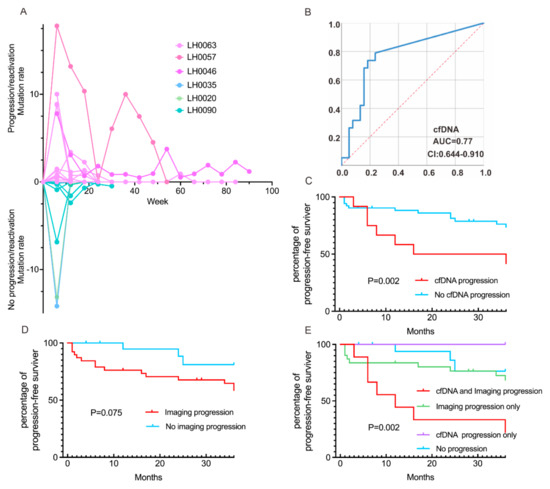
Figure 2.
(A) Spider plot demonstrating sustained mutation rates in 25 cfBRAFV600E-positive children with LCH. Patients were divided into two groups based on whether they experienced disease progression. Patients are represented either above or below the horizontal axis. Each curve represents an individual patient, and each point reflects the mutation value of the patient at a specific time. (B) ROC analyses of the truncated value of cfBRAFV600E. AUC: Area Under the Curve; CI: Confidence Interval. (C–E) Patients with either cfBRAFV600E or imaging progression had a significantly shorter progression-free survival (PFS) compared to those without cfBRAFV600E or imaging progression.
3.3. Concordance of cfDNA Molecular and Radiographic Responses on Clinical Outcomes
Twelve (48.0%) of twenty-five patients experienced a progression in the proportion of cfBRAFV600E mutations during follow-up, and seven (58.3%) of these children exhibited LCH progression/reactivation, compared to 12 (21.8%) of 55 patients in the no molecular response group who showed LCH progression/reactivation. The progression/reactivation rate was significantly higher in children with cfDNA molecular progression compared to those without (58.3% vs. 21.8%, p = 0.011; Table 2). Patients with molecular progression attained a shorter PFS compared to those without (PFS expectancy 22.25 months versus 25.13 months, respectively; Figure 2C). In the imaging progression group, 16 (41%) of 39 children exhibited LCH progression/reactivation, while in the group without imaging progression, only 3 (15%) of 20 children showed LCH progression/reactivation. There was a statistically significant difference in the recurrence rate between the two groups (41% vs. 15%, p = 0.045; Table 2). Patients with imaging progression also attained a shorter PFS than those without (PFS expectancy 24.33 months versus 26.98 months, respectively; Figure 2D).

Table 2.
Concordance between radiographic and cfDNA molecular response for patients.
We then compared and analyzed the combined effect of molecular and imaging progression in assessing clinical outcomes in children LCH patients. Among the eight children in the cfBRAFV600E and imaging progression group, six (75%) showed LCH progression/reactivation. In the group with neither molecular nor imaging progression, consisting of 18 cases, only 3 (16.7%) exhibited progression or reactivation. The molecular and imaging progression group was significantly more likely to experience relapse or progression compared to the group without molecular and radiologic progression (75% vs. 16.7%, p = 0.004; Table 2). Patients with cfBRAFV600E and imaging progression attained a shorter PFS than those without (PFS expectancy 17.67 months versus 24.67 months, respectively; Figure 2E). The sensitivity of molecular progression in predicting the best overall response (BOR) of radiologic progression was 20.5%, with a specificity of 85.7% and a kappa value of 0.048.
The overall radiographic response was evaluated in the 12th week. Tumor responses were classified into two groups: radiographic response (complete response (CR) and partial response (PR)) and no radiographic response (stable disease (SD) and progressive disease (PD)). The maximal mutant allele fraction (max MAF) was tracked at the 6th-weektreatment timepoint (C1M1) to on-therapy 12th- and 18th-week timepoints (C2M1 and C3M1). Among the patients, LH0057, LH0035, and LH0020 exhibited high levels of cfBRAFV600E mutations and showed no radiographic response (SD and PD), with LH0057 demonstrating persistent cfBRAFV600E positivity across all time points (Figure 3). Imaging analysis showed a stable left temporal bone lesion in LH0008 (Figure 4A), and digital PCR results revealed an increasing proportion of mutations (Figure 4B). In contrast, patients with radiographic responses (CR and PR) showed predominantly low cfBRAFV600E mutation rates, as seen in the heatmap (Figure 3).
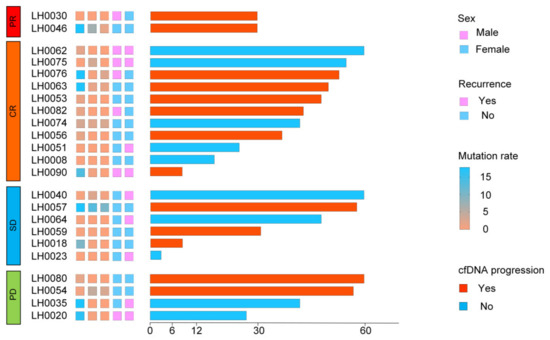
Figure 3.
Analyses of PFS by cfDNA molecular response and radiographic response assessment. The swimmer plot depicts the timing of radiographic response assessment, molecular response trajectory, and PFS for each evaluable patient with an increased percentage of cfDNA mutations. Patients were grouped according to their radiographic response and categorized as CR, PR, SD, and PD. The 5-column heatmap represents, from left to right, the proportion of cfDNA mutations, sex, and recurrence at time points C1M1, C2M1, and C3M1, respectively. Bars represent the PFS of the affected children. CR: complete response; PR: partial response; SD: stable disease; PD: progressive disease; C1M1: the 6th-week treatment timepoint; C2M1: the 12th-week treatment timepoint; and C3M1: the 18th-week treatment timepoint.
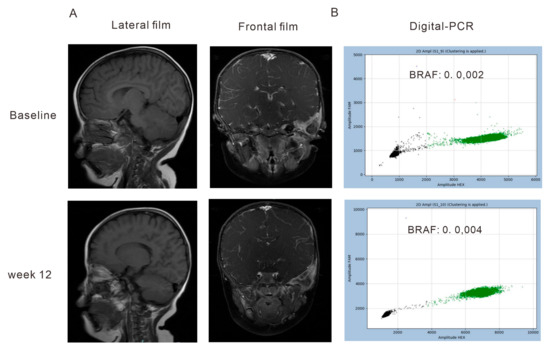
Figure 4.
Imaging features of left temporal bone lesions and proportion of mutations detected by digital PCR. A 2-year-old boy with a temporal bone lesion diagnosed as multisystem Langerhans cell histiocytosis–risk organ invasion. (A) T1-weighted imaging (T1WI) from lateral and frontal views shows the temporal bone and its surrounding tissues at the start of treatment and after 12 weeks of treatment. (B) The BRAFV600E mutation rate of the child detected by digital PCR after 6 and 12 weeks of treatment.
3.4. Comparison of cfBRAFV600E and ltBRAFV600E Status in Relation to LCH Clinical Presentations and Outcomes
A total of 25 cases of cfBRAFV600E and 35 cases of ltBRAFV600E tested positive in the study. Among them, 24 cases were positive for cfBRAFV600E and ltBRAFV600E. Eleven cases were positive for ltBRAFV600E but negative for cfBRAFV600E. This discrepancy may stem from the differing biological sources for ltDNA and cfDNA. While ltDNA detects genetic mutations directly within tumor tissues, cfDNA identifies free tumor DNA in peripheral circulating plasma. In cases with a limited number of tumor cells, cfDNA may yield false-negative results, necessitating multiple tests or a combination of imaging and other modalities for accurate tumor detection. One patient was positive for cfBRAFV600E at diagnosis but negative for ltBRAFV600E. Additionally, 33 children had undetectable mutations during follow-up.
The cfBRAFV600E mutation was significantly associated with younger age at diagnosis (median 2.17 years [1.5–7] vs. 5.08 years [2,3,4,5,6,7,8,9], p = 0.036), a higher proportion of patients under 3 years old (64% vs. 32%, p = 0.012), a greater proportion of RO+ LCH (52% vs. 27.9%, p = 0.047), involvement of the skin (36% vs. 7%, p = 0.002) and spleen (36% vs. 7%, p = 0.002), the treatment response at the sixth week (24% vs. 4.7%, p = 0.002), and a higher 3-year PFS rate (37.5% vs. 90.7%, p < 0.0001) compared to patients without the mutation (Table 3, Figure 5A). Similarly, the ltBRAFV600E was significantly associated with a higher proportion of patients under 3 years old (57.1% vs. 30.3%, p = 0.026), the involvement of the skin (31.4% vs. 3%, p = 0.002) and spleen (28.6% vs. 6.1%, p = 0.015), and pituitary (14.3% vs. 0.0%, p = 0.024), as well as a better 3-year PFS rate (57.1% vs. 87.9%, p = 0.005) compared to patients without the mutation (Table 3, Figure 5B). Additionally, we observed significant differences among patients in Group A (positive for both ltBRAFV600E and cfBRAFV600E), Group B (positive for either ltBRAFV600E or cfBRAFV600E), and Group C (negative for both mutations) regarding the proportion of children under 3 years of age (66.7%, 33.3%, and 31.3%, p = 0.021), skin involvement (37.5%, 16.7%, and 3.1%, p = 0.003), and spleen involvement (37.5%, 8.3%, and 6.3%, p = 0.005), and the 3-year PFS rate (34.8%, 100%, and 87.5%, p < 0.001) (Table 3). The cfBRAFV600E was related to 3-year PFS in patients with SS-LCH, MM-LCH, and RO+ LCH (Figure 6A,D,G,H), while the ltBRAFV600E was related to 3-year PFS in patients with SS-LCH (Figure 6B,E). There were significant differences among Groups A, B, and C in patients with SS-LCH and MM-LCH (Figure 6C,F,I).

Table 3.
Correlation of cfBRAFV600E and ltBRAFV600E with clinical characteristics, treatment response, and outcomes.
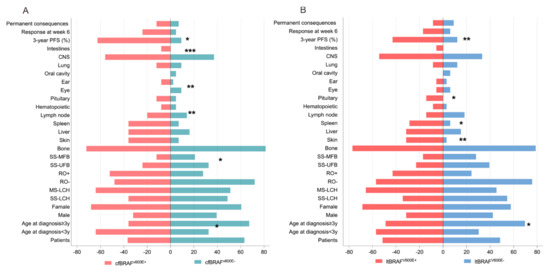
Figure 5.
(A) Clinical characteristics, treatment response, and outcomes between cfBRAFV600E-negative and cfBRAFV600E-positive. (B) Clinical characteristics, treatment response, and outcomes between ltBRAFV600E-negative and ltBRAFV600E-positive. * p < 0.05, ** p < 0.01, *** p < 0.001. Y: Year; SS-LCH: single system Langerhans cell histiocytosis; MS-LCH: multisystem Langerhans cell histiocytosis; RO-: no risk organ invasion; RO+: risk organ invasion; CNS: central nervous system; PFS: progression-free survival; SS-UFB: unifocal bone disease; SS-MFB: multifocal bone disease.
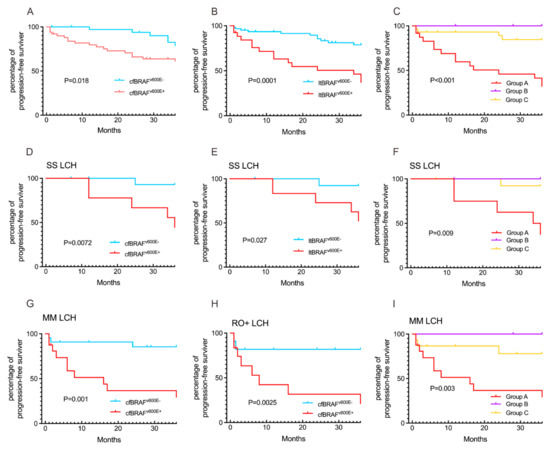
Figure 6.
(A) Three-year progression-free survival (PFS) in the cfBRAF mutation cohort of 68 patients. (B) Three-year PFS in the cfBRAF mutation cohort of 68 patients. (C) Three-year PFS in the BRAF mutation cohort of 68 patients. (D,G,H) Patients with cfBRAFV600E-positive had a longer PFS compared to patients with cfBRAFV600E-negative in subtypes SS-LCH and MS-LCH, RO+ LCH. (F,I) Three-year PFS in the BRAF mutation cohort of 68 patients in subtypes SS-LCH and MS-LCH. (E) Patients with ltBRAFV600E-positive had a longer PFS compared to patients with ltBRAFV600E-negative in subtypes SS-LCH. SS-LCH: single system Langerhans cell histiocytosis; MS-LCH: multisystem Langerhans cell histiocytosis; RO+-LCH: risk organ invasion Langerhans cell histiocytosis. Group A: positive for both ltBRAFV600E and cfBRAFV600E; Group B: positive for either ltBRAFV600E or cfBRAFV600E; and Group C: negative for both mutations.
3.5. MAP2K1 and BRAFexon12 Mutations in Relation to LCH Clinical Presentations and Outcomes
Among the 119 patients enrolled, 25 cases of cfBRAFV600E and 35 cases of ltBRAFV600E were positive. ltMAP2K1+ mutations were found in 11 (19.6%) patients, ltBRAF-exon12+ in 6 (10.7%) patients, ltBRAF-V600D+ in 3 patients, and 1 patient had an ARAF mutation; moreover, 33 patients with no detected mutations served as the control group (Figure 7A). The clinical characteristics, treatment response, and outcome of MAP2K1 and BRAFexon12 mutations are specifically analyzed and discussed, which serves as a reference for patients with detectable mutations in the MAPK signaling pathway other than BRAFV600E. Compared with children without mutations, patients with MAP2K1 mutations had significantly more ear involvement (27.3% vs. 1%; p = 0.045) (Supplementary Table S3). No significant differences in clinical characteristics, treatment response, and outcomes were observed between the BRAFexon12 mutations group and the no mutation group (Supplementary Table S3). The consistency between the clinical characteristics of different mutations in cfDNA and ltDNA assays was compared. Regarding this, cfBRAFV600E mutations appeared to correlate with younger age at diagnosis compared to ltBRAFV600E, MAP2K1, or BRAFexon12 mutations (3.55 ± 3.11, 4.10 ± 3.54, 4.38 ± 3.24 vs. 6.92 ± 3.24 years, respectively) (Figure 7B). Figure 7C highlights the proportion of subtype extents in patients with cfBRAFV600E, ltBRAFV600E, BRAFexon12, or MAP2K1 mutations. Children with BRAFexon12 mutations were more likely to have SS-LCH (83.3% vs. 36%, 34.3%, 54.5%) and less likely to have MS-LCH (16.7% vs. 64%, 65.7%, 45.5%) compared to patients with cfBRAFV600E, ltBRAFV600E, or MAP2K1 mutations (Figure 7D). Regarding bone involvement subtypes, patients with BRAFexon12 mutations had the highest prevalence of SS-UFB (83.3% vs. 24%, 22.9%, 54.5%; p < 0.05) and the lowest prevalence of SS-MFB (0% vs. 12%, 17.1%, 18.2%) compared to those with cfBRAFV600E, ltBRAFV600E, or MAP2K1 mutations (Figure 7E).
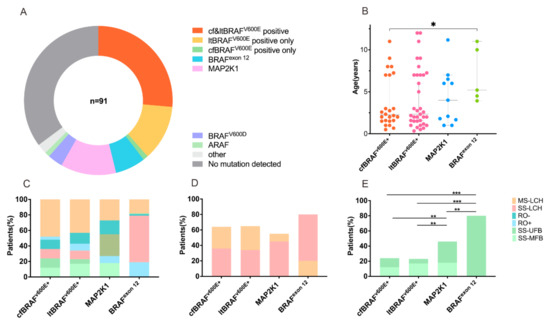
Figure 7.
Clinical characteristics in LCH children with cfBRAFV600E, ltBRAFV600E, BRAFexon12, or MAP2K1 mutations. (A) The pie chart shows the mutational status of the 91 patients in our cohort. (B) Dot plot shows age at diagnosis of patients with cfBRAFV600E, ltBRAFV600E, BRAFexon12, or MAP2K1 mutations. Error bars depict medians with interquartile ranges. (C–E) Bar charts demonstrate the percentage of patients with cfBRAFV600E, ltBRAFV600E, BRAFexon12, or MAP2K1 mutations having subtypes at LCH diagnosis. SS-LCH: single system Langerhans cell histiocytosis; MS-LCH: multisystem Langerhans cell histiocytosis; RO-: no risk organ invasion; RO+: risk organ invasion; SS-UFB: unifocal bone disease; SS-MFB: multifocal bone disease. * p < 0.05, ** p < 0.01, *** p < 0.001.
4. Discussion
A critical challenge in optimal tumor monitoring lies in the heterogeneity of tumor clinical presentations, the limitations of imaging in detecting measurable residual disease, and the difficulty of real-time assessment to guide treatment regimens [1,6,22,27]. Liquid biopsy represents a significant advancement, shifting from the surgical removal of tumor tissue specimens to the less invasive extraction of blood samples by nursing staff. This marks a major step forward in tumor detection. Liquid biopsy has made tumor load monitoring both rapid and easy to perform in real time [4,28,29].
Including the significance of cfDNA molecular responses, substantial progress has been made in the application of cfDNA in LCH [23,30,31]. Nonetheless, more information still needs to be duly confirmed. Our paper aims to explore the concordance between cfDNA and imaging analysis in the monitoring of LCH. The combination of molecular and radiographic responses proved to be more informative in predicting PFS. We found that children with LCH who exhibited both cfBRAFV600E progression and imaging progression had significantly lower PFS compared to those without, as well as those with only cfBRAFV600E progression or only imaging progression. Both cfBRAFV600E progression and imaging progression can be used as markers of poor prognosis or the need for intensified treatment in children with LCH. ctDNA captures tumor DNA from peripheral circulation and offers superior sensitivity and specificity for detecting microscopic residual disease compared to imaging analysis. It enables real-time monitoring of tumor dynamics, facilitating earlier detection of recurrence. Additionally, ctDNA testing eliminates the need for invasive procedures and minimizes radiation exposure associated with imaging, thereby enhancing patient comfort and safety.
This paper is based on data visualization and a survival analysis model analyzing long-term ctDNA and imaging data of 119 children with LCH. This resulted in 25 cases of cfBRAFV600E positivity, 35 cases of ltBRAFV600E positivity, 21 cases with other gene mutations, and 33 cases with no detectable mutations; these totals served as informative information to obtain the concordance between cfBRAFV600E mutations and imaging responses, as well as the relationship between cfBRAFV600E and ltBRAFV600E status in relation to LCH clinical presentation and prognosis. Compared to parents included in the Toronto cohort, we observed a higher frequency of positive ltBRAFV600E (38.5% vs. 31.53%). Similarly, our cohort demonstrated a higher frequency of detectable cfBRAFV600E mutations compared to the French cohort (27.5% vs. 10.5%) [23,31]. These differences are likely related to ethnic and geographical factors. In this study, we also aimed to use cfDNA-detected mutations in LCH as an enrichment strategy to identify individuals at high risk for disease progression, recurrence, response to chemotherapy, and early detection of organ-at-risk involvement, enabling timely preventive measures [28]. We found that cfDNA progression was closely related to relapse and progression. We propose that cfBRAFV600E progression can serve as an indicator for treatment escalation in LCH. A prospective study could be conducted to adjust treatment regimens early in children with cfDNA progression in LCH. In addition, cfBRAFV600E has been reported as an independent risk factor for LCH in adults and children, and we determined the cut-off value for cfBRAFV600E in this context.
The cfBRAFV600E and ltBRAFV600E mutations were associated with a higher proportion of children under 3 years of age, skin and spleen involvement, and a lower 3-year PFS rate. In addition, we observed 11 cases that tested positive for ltBRAFV600E but negative for cfBRAFV600E. This discrepancy is attributed to the differing bio-materials of ltDNA and cfDNA. While ltDNA directly detects mutations within tumor tissues, cfDNA identifies free tumor DNA circulating in peripheral plasma. These factors contribute to a higher incidence of false-negative results with cfDNA when tumor cell numbers are limited. However, these same characteristics position cfDNA as a more promising indicator of prognosis and treatment efficacy [32]. This observation was further validated in our study. We found that cfBRAFV600E-positive children were diagnosed at a younger age and had more RO+ involvement. These children also had a poorer treatment response at the sixth week and were more likely to require a change in regimen, whereas a distinction was not observed with ltBRAFV600E. Additionally, cfBRAFV600E-positive children had a lower 3-year PFS in both RO+-LCH and MS-LCH subtypes, a unique finding that distinguishes ltBRAFV600E-positive patients. No significant differences were found in clinical classification, tumor invasion sites, response to treatment, clinical outcomes, or permanent damage between children with MAP2K1 or cfBRAFexon12 mutations and those without detectable mutations.
In the future, at the time of initial diagnosis, cfDNA will be the preferred monitoring method in the treatment regimen in LCH clinical guidelines for small or undersized lesions. As our findings showed, in RO+-LCH and MS-LCH subtypes, the 3-year-PFS was significantly lower in the cfBRAFV600E-positive group than in the cfBRAFV600E-negative group. We demonstrated that cfBRAFV600E predicted treatment response, whereas ltBRAFV600E did not. Our study underscored the importance of cfDNA molecular responses in childhood LCH, and we successfully established a cut-off value for cfDNA molecular response. cfDNA holds potential for routine clinical application across various tumors. For instance, children with leukemia face high risks of morbidity and mortality from pancreatitis during treatment; early detection of pancreatic DNA in their peripheral blood could enable timely intervention, helping to prevent the onset of pancreatitis. This study has several limitations. First, the number of BRAF-positive patients decreased following the final detailed categorization. To better understand the potential impact of MAPK pathway mutations, it is necessary to gather a larger sample size and cohort of LCH patients for further validation. Additionally, as our center is located in the central region of the country, data from multiple centers should be included in future studies to mitigate potential geographical biases. Although the consistency of ctDNA testing and imaging analysis for LCH surveillance was initially evaluated in this paper, since ctDNA testing can sometimes yield false negatives, extending the follow-up period in future studies is crucial to reduce chance bias and ensure more robust results, which will potentially increase the number of investigators involved.
5. Conclusions
We revealed that the concordance between cfDNA molecular response and radiographic progression was highly relevant for tracking pediatric LCH progression and recurrence. The group with both molecular and imaging progression had a significantly higher likelihood of relapse or disease progression compared to the group without progression (p < 0.05). PFS was notably shorter in patients exhibiting both radiologic and cfDNA molecular progression (17.67 vs. 24.67 months, p < 0.05) compared to those without. Our study highlighted the significance of the molecular response of cfBRAFV600E, as we found that in RO+-LCH and MS-LCH subtypes, the 3-year PFS was significantly lower in the cfBRAFV600E-positive group compared to the cfBRAFV600E-negative group, a distinction not observed with ltBRAFV600E. Furthermore, the cut-off value of cfDNA molecular response is established. Our findings support the implementation of liquid biopsy in children with LCH and further advance the roadmap of evidence, paving the way for cfDNA molecular responses to play an increasing role in clinical decision-making for these patients.
Supplementary Materials
The following supporting information can be downloaded at: https://www.mdpi.com/article/10.3390/children11121449/s1, Supplementary Table S1. Diagnostic criteria, clinical classification, classification of organs at risk. Supplementary Table S2. The NCBI hg19 reference genome. Supplementary Table S3. Correlation of MAP2K1 and BRAFexon12 with clinical characteristics, treatment response, and outcome.
Author Contributions
Conceptualization: S.L. and A.L.; Data curation: S.L. and Y.Z.; Formal analysis: S.L. and Y.C.; Funding acquisition: A.L. and Q.H.; Investigation: S.L. and D.Z.; Methodology: S.L., Y.W. (Yaqin Wang) and J.Z.; Project administration: S.L., Y.W. (Yao Wang) and A.Z.; Resources: A.L. and Y.W. (Yaqin Wang); Software: S.L.; Supervision: A.L. and Q.H.; Validation: S.L. and Y.Z.; Visualization: S.L.; Writing—original draft: S.L.; Writing—review and editing: S.L. and A.L. All authors have read and agreed to the published version of the manuscript.
Funding
This study was supported by the National Key Research and Development Program of China (#2022YFC2705003).
Institutional Review Board Statement
All procedures performed in studies involving human participants were conducted according to the guidelines of the 1994 Declaration of Helsinki, and approved by the Medical Ethics Committee of Beijing Children’s Hospital, Capital Medical (ChiCTR1900025783, approved on 7 September 2019).
Informed Consent Statement
Informed consent was obtained from the parent or legal guardian of each individual participant included in the study.
Data Availability Statement
The datasets generated or analyzed during the study are available from the corresponding author on reasonable request.
Conflicts of Interest
No financial or non-financial benefits have been received or will be received from any party related directly or indirectly to the subject of this paper.
References
- Allen, C.E.; Longo, D.L.; Merad, M.; McClain, K.L. Langerhans-Cell Histiocytosis. N. Engl. J. Med. 2018, 379, 856–868. [Google Scholar] [CrossRef] [PubMed]
- Hagey, D.W.; Kvedaraite, E.; Akber, M.; Görgens, A.; Javadi, J.; Von Bahr Greenwood, T.; Björklund, C.; Åkefeldt, S.O.; Hannegård-Hamrin, T.; Arnell, H.; et al. Myeloid cells from Langerhans cell histiocytosis patients exhibit increased vesicle trafficking and an altered secretome capable of activating NK cells. Haematologica 2023, 108, 2422–2434. [Google Scholar] [CrossRef] [PubMed]
- Liu, R.; Guo, Y.; Han, L.; Feng, S.; Cao, J.; Sun, Y.; Cao, Z.; Cui, X. Somatic ARAF mutations in pediatric Langerhans cell histiocytosis: Clinicopathologic, genetic and functional profiling. Clin. Exp. Med. 2023, 23, 5269–5279. [Google Scholar] [CrossRef] [PubMed]
- Krooks, J.; Minkov, M.; Weatherall, A.G. Langerhans cell histiocytosis in children: History, classification, pathobiology, clinical manifestations, and prognosis. J. Am. Acad. Dermatol. 2018, 78, 1035–1044. [Google Scholar] [CrossRef]
- Rodriguez-Galindo, C. Clinical features and treatment of Langerhans cell histiocytosis. Acta Paediatr. 2021, 110, 2892–2902. [Google Scholar] [CrossRef]
- Goyal, G.; Tazi, A.; Go, R.S.; Rech, K.L.; Picarsic, J.L.; Vassallo, R.; Young, J.R.; Cox, C.W.; Van Laar, J.; Hermiston, M.L.; et al. International expert consensus recommendations for the diagnosis and treatment of Langerhans cell histiocytosis in adults. Blood 2022, 139, 2601–2621. [Google Scholar] [CrossRef]
- Bigenwald, C.; Le Berichel, J.; Wilk, C.M.; Chakraborty, R.; Chen, S.T.; Tabachnikova, A.; Mancusi, R.; Abhyankar, H.; Casanova-Acebes, M.; Laface, I.; et al. BRAF(V600E)-induced senescence drives Langerhans cell histiocytosis pathophysiology. Nat. Med. 2021, 27, 851–861. [Google Scholar] [CrossRef]
- Cohen Aubart, F.; Idbaih, A.; Emile, J.F.; Amoura, Z.; Abdel-Wahab, O.; Durham, B.H.; Haroche, J.; Diamond, E.L. Histiocytosis and the nervous system: From diagnosis to targeted therapies. Neuro Oncol. 2021, 23, 1433–1446. [Google Scholar] [CrossRef]
- Cournoyer, E.; Ferrell, J.; Sharp, S.; Ray, A.; Jordan, M.; Dandoy, C.; Grimley, M.; Roy, S.; Lorsbach, R.; Merrow, A.C.; et al. Dabrafenib and trametinib in Langerhans cell histiocytosis and other histiocytic disorders. Haematologica 2023, 109, 1137. [Google Scholar] [CrossRef]
- Kim, J.R.; Yoon, H.M.; Jung, A.Y.; Cho, Y.A.; Seo, J.J.; Lee, J.S. Comparison of whole-body MRI, bone scan, and radiographic skeletal survey for lesion detection and risk stratification of Langerhans Cell Histiocytosis. Sci. Rep. 2019, 9, 317. [Google Scholar] [CrossRef]
- Gulati, N.; Allen, C.E. Langerhans cell histiocytosis: Version 2021. Hematol. Oncol. 2021, 39 (Suppl. 1), 15–23. [Google Scholar] [CrossRef] [PubMed]
- Thalhammer, J.; Jeziorski, E.; Marec-Berard, P.; Barkaoui, M.A.; Pagnier, A.; Rohrlich, P.S.; Chevallier, A.; Carausu, L.; Aladjidi, N.; Rigaud, C.; et al. Childhood Langerhans cell histiocytosis hematological involvement: Severity associated with BRAFV600E loads. Blood 2024. Online ahead of print. [Google Scholar] [CrossRef] [PubMed]
- Gao, X.M.; Li, J.; Cao, X.X. Signaling pathways, microenvironment, and targeted treatments in Langerhans cell histiocytosis. Cell Commun. Signal. 2022, 20, 195. [Google Scholar] [CrossRef]
- Sconocchia, T.; Foßelteder, J.; Sconocchia, G.; Reinisch, A. Langerhans cell histiocytosis: Current advances in molecular pathogenesis. Front. Immunol. 2023, 14, 1275085. [Google Scholar] [CrossRef]
- Lang, M.; Chang, L.; Cai, H.; Lin, H.; Liu, Z.Z.; Duan, M.H.; Zhou, D.B.; Cao, X.X. BRAF deletion in adult patients with Langerhans cell histiocytosis correlates with multisystem disease and poor outcome. Clin. Cancer Res. 2024. Online ahead of print. [Google Scholar] [CrossRef]
- Jouenne, F.; Tazi, A. The MAPK Pathway in Pulmonary Langerhans Cell Histiocytosis. Arch. Bronconeumol. 2023, 59, 347–349. [Google Scholar] [CrossRef]
- Ji, H.; Long, X.; Gu, J.; Jin, J.; Mao, X.; Wang, Z.; Ma, H.; Chen, L. Longitudinal Monitoring of Plasma Circulating Tumour DNA Enables the Prediction of Early Relapse in Patients with Non-Hodgkin Lymphoma: A Case Series. Diagnostics 2021, 11, 2055. [Google Scholar] [CrossRef]
- Chen, J.; Zhao, A.; Duan, M.; Cai, H.; Gao, X.; Liu, T.; Sun, J.; Liang, Z.; Zhou, D.; Cao, X.; et al. Diverse kinase alterations and myeloid-associated mutations in adult histiocytosis. Leukemia 2022, 36, 573–576. [Google Scholar] [CrossRef]
- Yang, Y.; Wang, C.; Wang, D.; Cui, L.; Li, N.; Lian, H.; Ma, H.; Zhao, Y.; Zhang, L.; Liu, W.; et al. Clinical study of MAP2K1-mutated Langerhans cell histiocytosis in children. J. Cancer Res. Clin. Oncol. 2022, 148, 2517–2527. [Google Scholar] [CrossRef]
- Ding, Z.; Wang, N.; Ji, N.; Chen, Z.S. Proteomics technologies for cancer liquid biopsies. Mol. Cancer 2022, 21, 53. [Google Scholar] [CrossRef]
- Nikanjam, M.; Kato, S.; Kurzrock, R. Liquid biopsy: Current technology and clinical applications. J. Hematol. Oncol. 2022, 15, 131. [Google Scholar] [CrossRef] [PubMed]
- Bagnasco, F.; Zimmermann, S.Y.; Egeler, R.M.; Nanduri, V.R.; Cammarata, B.; Donadieu, J.; Lehrnbecher, T.; Haupt, R. Langerhans cell histiocytosis and associated malignancies: A retrospective analysis of 270 patients. Eur. J. Cancer 2022, 172, 138–145. [Google Scholar] [CrossRef]
- Heritier, S.; Helias-Rodzewicz, Z.; Lapillonne, H.; Terrones, N.; Garrigou, S.; Normand, C.; Barkaoui, M.A.; Miron, J.; Plat, G.; Aladjidi, N.; et al. Circulating cell-free BRAF(V600E) as a biomarker in children with Langerhans cell histiocytosis. Br. J. Haematol. 2017, 178, 457–467. [Google Scholar] [CrossRef]
- Makras, P.; Yavropoulou, M.P.; Chatziioannou, S.N.; Anastasilakis, A.D.; Georgakopoulou, D.; Tsoli, M.; Chatzelis, E.; Kaltsas, G. Efficacy of denosumab monotherapy among adults with Langerhans cell histiocytosis: A prospective clinical trial. Am. J. Hematol. 2023, 98, E168–E171. [Google Scholar] [CrossRef]
- Cui, L.; Wang, C.J.; Lian, H.Y.; Zhang, L.; Ma, H.H.; Wang, D.; Chen, F.F.; Zhang, Q.; Yang, Y.; Wei, A.; et al. Clinical outcomes and prognostic risk factors of Langerhans cell histiocytosis in children: Results from the BCH-LCH 2014 protocol study. Am. J. Hematol. 2023, 98, 598–607. [Google Scholar] [CrossRef]
- Evseev, D.; Osipova, D.; Kalinina, I.; Raykina, E.; Ignatova, A.; Lyudovskikh, E.; Baidildina, D.; Popov, A.; Zhogov, V.; Semchenkova, A.; et al. Vemurafenib combined with cladribine and cytarabine results in durable remission of pediatric BRAF V600E-positive LCH. Blood Adv. 2023, 7, 5246–5257. [Google Scholar] [CrossRef]
- Liu, S.Y.; Chang, L.W.; Wang, J.; Xie, M.; Chen, L.L.; Liu, W. Ursodeoxycholic acid prevention on cholestasis associated with total parenteral nutrition in preterm infants: A randomized trial. World J. Pediatr. WJP 2022, 18, 100–108. [Google Scholar] [CrossRef]
- Lueong, S.S.; Herbst, A.; Liffers, S.-T.; Bielefeld, N.; Horn, P.A.; Tannapfel, A.; Reinacher-Schick, A.; Hinke, A.; Hegewisch-Becker, S.; Kolligs, F.T.; et al. Serial Circulating Tumor DNA Mutational Status in Patients with KRAS-Mutant Metastatic Colorectal Cancer from the Phase 3 AIO KRK0207 Trial. Clin. Chem. 2020, 66, 1510–1520. [Google Scholar] [CrossRef]
- Long, X.; Xu, Q.; Lou, Y.; Li, C.; Gu, J.; Cai, H.; Wang, D.; Xu, J.; Li, T.; Zhou, X.; et al. The utility of non-invasive liquid biopsy for mutational analysis and minimal residual disease assessment in extramedullary multiple myeloma. Br. J. Haematol. 2020, 189, e45–e48. [Google Scholar] [CrossRef]
- Cheng, M.L.; Pectasides, E.; Hanna, G.J.; Parsons, H.A.; Choudhury, A.D.; Oxnard, G.R. Circulating tumor DNA in advanced solid tumors: Clinical relevance and future directions. CA A Cancer J. Clin. 2020, 71, 176–190. [Google Scholar] [CrossRef]
- Tandon, S.; Weitzman, S.; Joyce, B.; McGuire, B.; Stephens, D.; Whitlock, J.; Hawkins, C.; Ngan, B.Y.; Abla, O. Expression and Clinical Correlation of PD-1/PD-L1 and VE1(BRAFp.V600E) in Pediatric Langerhans Cell Histiocytosis. Mediterr. J. Hematol. Infect. Dis. 2023, 15, e2023035. [Google Scholar] [CrossRef] [PubMed]
- Cui, L.; Zhang, L.; Ma, H.H.; Wang, C.J.; Wang, D.; Lian, H.Y.; Li, W.J.; Zhang, Q.; Li, N.; Wang, T.Y.; et al. Circulating cell-free BRAF V600E during chemotherapy is associated with prognosis of children with Langerhans cell histiocytosis. Haematologica 2020, 105, e444–e447. [Google Scholar] [CrossRef]
Disclaimer/Publisher’s Note: The statements, opinions and data contained in all publications are solely those of the individual author(s) and contributor(s) and not of MDPI and/or the editor(s). MDPI and/or the editor(s) disclaim responsibility for any injury to people or property resulting from any ideas, methods, instructions or products referred to in the content. |
© 2024 by the authors. Licensee MDPI, Basel, Switzerland. This article is an open access article distributed under the terms and conditions of the Creative Commons Attribution (CC BY) license (https://creativecommons.org/licenses/by/4.0/).